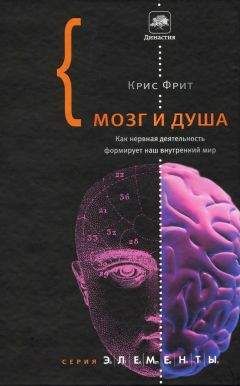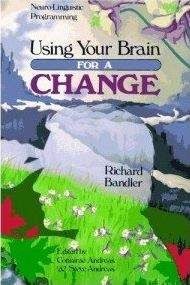Richard Bandler - Frogs into Princes: Neuro Linguistic Programming

Скачивание начинается... Если скачивание не началось автоматически, пожалуйста нажмите на эту ссылку.
Жалоба
Напишите нам, и мы в срочном порядке примем меры.
Описание книги "Frogs into Princes: Neuro Linguistic Programming"
Описание и краткое содержание "Frogs into Princes: Neuro Linguistic Programming" читать бесплатно онлайн.
What People are saying about this book:
"A readable, practical, and entertaining book about a challenging, original, and promising new discipline. I recommend it."—Dan Goleman, Associate Editor of Psychology Today.
"NLP represents a huge quantum jump in our understanding of human behavior and communication. It makes most current therapy and education totally obsolete."—John O. Stevens, author of Awareness and editor of Gestalt Therapy Verbatim and Gestalt is.
"This book shows you how to do a little magic and change the way you see, hear, feel, and imagine the world you live in. It presents new therapeutic techniques which can teach you some surprising things about yourself."—Sam Keen, Consulting Editor of Psychology Today and author of Beginnings Without End, To a Dancing God, and Apology for Wonder.
"How tiresome it is going from one limiting belief to another. How joyful to read Bandler and Grinder, who don't believe anything, yet use everything! NLP wears seven-league-boots, and takes 'therapy' or 'personal growth' far, far beyond any previous notions."—Barry Stevens, author of Don't Push the River, and co-author of Person to Person.
"Fritz Perls regarded John Stevens' Gestalt Therapy Verbatim as the best representation of his work in print. Grinder and Bandler have good reason to have the same regard for Frogs into Princes. Once again, it's the closest thing to actually being in the workshop."— Richard Price, Co-founder and director of Esalen Institute.
Now, there was a difference between the last set of responses and the previous set.
Now I'm going to shift my questions again.
Do you know the feeling of water swirling around your body when you swim?... What happens in winter when you are in a nice, warm, cozy house, and you walk out into the cold air outside?... (Fran and Harvey look down and to their right while accessing the answer to each question; Susan looks down and to her left.)
Can you make a connection between the classes of questions I was asking and the kind of movements that you were seeing? What did you actually see in your sensory experience when I asked the questions?
Man: I noticed especially that when it seemed like Susan was picturing something, she would look up. And then there were times when she would look straight ahead.
OK. I agree with you. How do you know when she was picturing something? That's an assumption on your part. What were the questions that I was asking that those movements were responses to?
Man: The color of eyes. How many lights—like she was picturing the intersections.
So the questions I was asking demanded visual information by presupposition. And the responses you noticed were a lot of up movements. Did you notice any preference as to side?
Woman: Susan looked to her right. She looked to her right because she is left-handed.
Because she's left-handed Susan looks to her right? She doesn't always look to her right. Watch this.
Susan, do you know what you would look like with long flaming red hair?... Do you know what you would looklike if you had a beard?... Do you know what you look like sitting right here?... (Her eyes move up and to her left.) Which way did her eyes go that time? Distinguish left and right with respect to her. You said that she typically went up to her right in answering the previous visually-oriented questions. What movement did you see with her eyes just now, in response to the last questions? This time her eyes dilated and moved up to her left and back. So she doesn't always look up and to her right. She sometimes looks up and to her left. There's a systematic difference between the kind of questions I asked just now, and the kind of visual questions I was asking before. Can you describe the difference?
Woman: The first questions had to do with experiences she was remembering, and the second group she had not experienced and was trying to visualize.
Excellent. The first set of pictures we call eidetic or remembered images, and the second set we call constructed images. She's never seen herself sitting here in this chair in this room. It's something she has had no direct visual experience of, therefore she has to construct the image in order to see what it is that she would look like.
Most "normally organized" right-handed people will show the opposite of what we've seen with Susan here. Susan is left-handed and her visual accessing cues are reversed left to right. Most people look up and to their left for visual eidetic images and up and to their right for constructed visual images.
However, lots of normally organized right-handers will look up and to their right as they respond to questions about visual memory. Barbara, here in the audience, looked up and to her right to recall something a few moments ago. Do you remember what it was you saw up there?
Barbara: No.
Do you remember one of the houses you lived in as a child?
Barbara: Yes, I do.
She just went up and to her right again. What did you see, Barbara? Name one thing you saw.
Barbara: I saw the living room.
I'm going to predict that the living room that you saw was peculiar in a specific way. I want you to check this and let me know whether my statements are accurate. The living room you saw was suspended in space. It wasn't bounded in the way it would be bounded visually if you were actually inside of that living room. It was an image which you had never seen before because it was a fragment of a set of images you'd seen lots of times in the past. It was not a visual input that you've ever had directly. It was literally extracted, a piece of a picture extracted from some part of your experience and displayed separately. Is that accurate?
Barbara: Yes.
When you ask visual memory questions and a person looks up to their right, you cannot conclude that they are left-handed or that their accessing cues are reversed. All you can conclude is that they looked up and to their right. If you want to explore it further, there are a couple of possibilities. One is what's true of Susan—namely, that she has reversed cerebral organization. The other possibility is that they could be constructing images of the past, as is true of Barbara. If that is so, the images will not have the color, the detail, the contextual markers, or the visual background that an actual eidetic remembered image has. That is an important difference.
When Barbara recalls images, she recalls them outside of context, which is characteristic of constructed images. By the way, she will argue about the past with people a lot—especially with someone who remembers eidetically.
Sally: I didn't see Fran's eyes going up or down, just straight.
OK. Was there any marked difference between the way she was looking straight at me before I asked a question and the way she continued to look straight at me after I'd asked the question? Did you notice any change?
Sally: Yes. She looked more pensive then.
"Pensive." What looks like "pensive" to you and what looks like "pensive" to me may be totally different kinds of experiences. "Pensive" is a complex judgement about experience; it's not in your sensory experience. I'm sure that "pensive" has appropriate meaning for you, and that you can connect; it with your sensory experience easily. So could you describe, so that we could agree or disagree, what you actually saw, as opposed to the judgement that she was being "pensive"?
As we said before, all these questions are being answered before the verbalization. So if you have the opportunity to watch anyone we're communicating with directly, you will always get the answer before they offer it to you verbally. I just asked Sally to describe something, and she demonstrated non-verbally what she saw. She mirrored in her own movements what Fran was doing.
Sally, do you remember the feeling of what you just did?
Sally: My eyes kind of closed a little.
So your eyelids dropped a little bit. Is there anything else that you could detect either from what you felt your eyes doing or from remembering what Fran was doing?...
Have you ever had the experience in a conversation that the other person's eyes are still resting on your face but somehow suddenly you are all by yourself? You are all alone? That's what was going on here. In both of these cases the pupils dilated and the facial muscles relaxed.
If you have trouble seeing pupil dilation, I believe that's not a statement about pupil dilation; it's a statement about your own perceptual programs. And I'm not talking about whether you have 20/20 vision or 20/2000 vision with corrective lenses. Your ability to perceive is something that is learned and you can learn to do it better. Most people act as if their senses are simply passive receptacles into which the world dumps vast amounts of information. There is a vast amount of information, so vast that you can only represent a tiny fraction of it. You learn to actively select in useful ways.
So what we’ll ask you to do in a few minutes is to change your perceptual programs to determine (1) whether the patterns we're talking about exist, and (2) whether they can be useful. We're going to proceed in that step-wise fashion. We're going to rely on whatever rapport we have with you to get you to do an exercise in which you discover for yourself, using your own sensory apparatus, whether in fact these things we're talking about are there. Then we'll talk about how to use them because that's the really important thing. The ultimate question is whether this is worth knowing about.
Let me reassure you that if you have patterns of communication that work for you now in therapy or education or business, those skills will still be available to you when we finish this seminar. I guarantee you that much. We're not going to do anything to take choices away. We would like you to consider a new approach. My guess is that some of you are quite effective and competent communicators therapeutically. You get results and you're pleased with them, and it's a challenge, and you like your job, at least some of the time. But even in the cases where you do very, very well indeed, you get bored from time to time. There's a tendency for you to repeat some set of interventions that you've made in the past which were successful, hoping for success again in the present. I think one of the most dangerous experiences human beings can have is success—especially if you have success early in your career—because you tend to become quite superstitious and repetitious. It's the old five-dollar bill at the end of the maze.
For example, say you once had somebody talk to an empty chair and visualize their mother in that chair and they dramatically changed. You might decide that every therapist in the country ought to do that, when in fact that's only one of a myriad ways of going about accomplishing the same result.
For those of you who are doubtful, and those who have skeptical parts, we would like to ask you—and this is true for all of the lies we are going to tell you—to do the following: accept our lie for a limited period of time, namely during the exercise that follows our description of the pattern we claim exists. In this way you can use your own sensory experience—not the crazy verbalizations we offer you—to decide whether in fact the things we describe can be observed in the behavior of the person you're communicating with.
We're making the claim right now that you've missed something that was totally obvious. We're claiming that you have been speaking to people your whole life and they've been going "Well, the way it looks to me..." (looks up and to his left), "I tell myself..." (looks down and to his left), "I just feel..."(looks down and to his right)—and you haven't consciously noticed that. People have been doing this systematically through a hundred years of modern psychology and communication theory and you've all been the victims of a set of cultural patterns which didn't allow you to notice and respond directly and effectively to those cues.
Accessing Cues Exercise:
Find someone you don't know, or you know minimally. One of you is going to be A and one of you is going to be B. A will begin asking questions. Make the task of learning this relatively simple for yourself by organizing your questions into sets the way I did. Start out by asking visual eidetic questions: What color are the carpets in your car? What color are your mother's eyes? What shape are the letters on the sign on the outside of this building? All of those are questions about things that people here have seen before.
Then ask questions about things that the person has not seen and will have to construct: How would you look from my point of view? How would you look with purple hair?
Then ask auditory questions: What's your favorite kind of music? Which door in your house sounds the loudest when it's slammed? Can you hear somebody very special that you are close to saying your name in a particularly delightful way? Can you hear yourself sing "Mary Had a Little Lamb"?
Visual accessing cues for a "normally organized" right-handed person.
Those are all ways of accessing auditory experience. The cues that the person will offer you non-verbally will be systematically different from the cues they offer you to the previous sets of questions. Then ask a set of kinesthetic questions: How do you feel early in the morning? What does cat fur feel like?
Visual accessing cues for a "normally organized" right-handed person.
Vc – Visual constructed images.
Vr – Visual remembered (eidetic) images.
(Eyes unmoving and defocused also indicates visual accessing)
Ac – Auditory constructed sounds or words.
Ar – Auditory remembered sounds or words.
K – Kinesthetic feelings (also smell and taste).
A – Auditory sounds or words.
Woman: Is there a difference between the eye movements people make when they are remembering something that they've heard in the past, and when they are trying to imagine what something would sound like?
When you say "imagine" that presupposes images or pictures. Ask them to create a sound they haven't heard before. There will be a difference, yes. Discover that for yourself.
I'd like to warn you of two pitfalls. You may think that the word "think" is one representational system. It's not. The words "think, understand, be aware of, believe, sense, know," are all unspecified. Do not use those words because the response you get will be random.
You will also get confusing responses if you say "Do you remember the last time you felt the feeling of swimming through the water?" You've asked them to do two things. You've asked them to remember and then to feel. They may remember visually; that is, they may search or scan visually, they may repeat it auditorily, or they may do it directly kinesthetically. However they do it, you are going to get a two-step process. One will be the remembering portion, following your instructions, and the other will be actually recovering those feelings of swimming.
If you get responses which do not make any sense to you, ask the person what they did internally. Your job is to correlate what you can observe on the outside with the questions you ask. Correlate the relationship between the kind of information you are asking for and the non-verbal eye movement responses you're getting from your partner. If you don't understand it, ask. "I saw this on the outside. What does that correspond to in your internal processing?" If they don't know, ask them to guess.
If you're not getting the kinds of eye movements we were talking about, make the question more difficult. "What color shoes was your mother wearing the last time you saw her?" If you ask "What color are your mother's eyes" and you don't see any movement, make the question more complex. "Your eyes are blue, too. Is the color of your eyes brighter or deeper in color than your mother's eyes?" That's a more complex, comparative question. She will then have to form an image of the color of her eyes and her mother's eyes and then make a visual comparison.
After four or five minutes of asking your partner these sets of questions, you should have an idea about what eye movements you can see which indicate unequivocally which of the internal representational systems that person is utilizing at that moment. Switch roles, so that both of you have the opportunity to ask questions and observe responses. If you run into things you don't understand, we will be wandering through the room—wave to us. We will come over and assist you in making sense out of it. We are offering you generalizations, and every single generalization anyone has ever offered you is going to be false at some time and some place. The generalizations are only tricks—as most of what we will do here is—to get you to pay attention to your experience, to notice a certain dimension of sensory experience which culturally you've been trained not to notice. Once you notice it, it constitutes a really powerful source of information about the other person's unconscious processes.
Подписывайтесь на наши страницы в социальных сетях.
Будьте в курсе последних книжных новинок, комментируйте, обсуждайте. Мы ждём Вас!
Похожие книги на "Frogs into Princes: Neuro Linguistic Programming"
Книги похожие на "Frogs into Princes: Neuro Linguistic Programming" читать онлайн или скачать бесплатно полные версии.
Мы рекомендуем Вам зарегистрироваться либо войти на сайт под своим именем.
Отзывы о "Richard Bandler - Frogs into Princes: Neuro Linguistic Programming"
Отзывы читателей о книге "Frogs into Princes: Neuro Linguistic Programming", комментарии и мнения людей о произведении.










